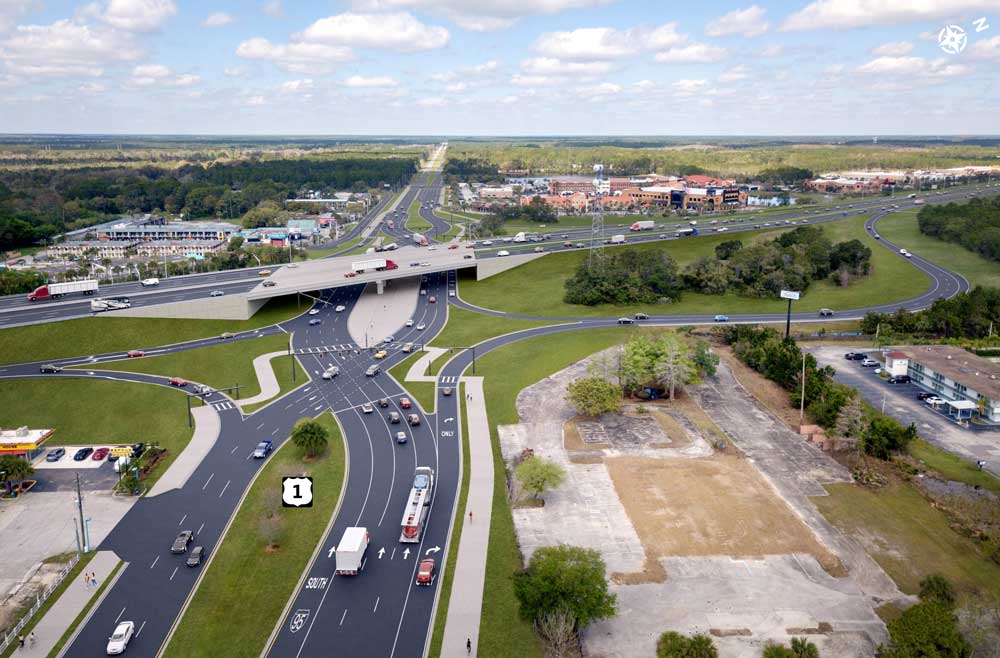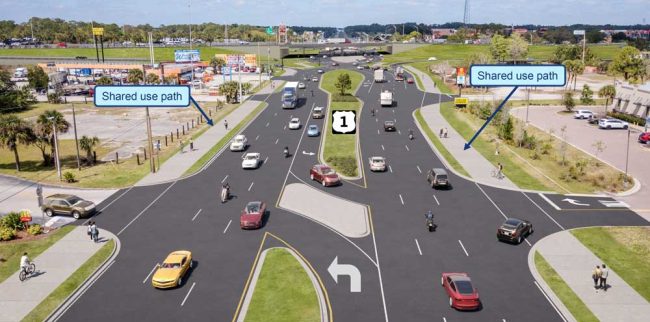
It’s one of the largest and costliest planned infrastructure projects in the region in a single spot, using a relatively new concept in interchange engineering in the United States: a $257 million reconstruction of the I-95 interchange at U.S. 1, a few miles south of the Flagler-Volusia county line, into a “diverging diamond” intended to reduce crash-prone conflict points and increase roadway capacity, with additional lanes on U.S. 1 and shared-use paths for walkers and bikers.
The project length covers 6.39 miles in total, counting all four sets of lanes on the two crisscrossing highways. The design of the project alone cost $12.8 million and the development and environmental study $2.9 million. Acquisition of rights of way cost $38.4 million. Construction will cost what is currently estimated at $203 million, though that phase is not yet funded, and the cost could very well rise with time, as it already has. A previous estimate of construction cost in March 2023 was $169 million.
If funding is secured–it would have to be a state appropriation, likely blending state and federal infrastructure dollars–construction is slated to begin in the fall of 2027. Some 18 parcels will be impacted by the project, including two businesses that would have to be displaced.
Diverging diamond interchanges were first built in this country in 2009 (in Springfield, Missouri), the year Popular Science called them one of the 100 best innovations of the year, as if they were invented here. They were not. France has been building divergent diamond interchanges since the 1970s.
Some 90 such interchanges have been built in the United States since 2009, only about half a dozen of them in Florida, at high-volume interchanges. The diverging diamond lowers potential conflict points from 26 to 14, reducing collisions by half. According to the Federal Highway Administration, diverging diamond intersections cost less to build than traditional interchanges, and at higher-volume interchanges, can reduce delays by 15 to 60 percent while improving traffic efficiency–the number of cars making it through the intersection–by 10 to 30 percent. In one case study for an I-15 diamond interchange in Utah, the FAA concluded that “The new DDI can comfortably accommodate 40,000 vehicles per day, 10,000 more than the conventional diamond interchange alternative.” See more FAA details here.
The Florida Department of Transportation (FDOT) will hold the latest in a series of public meeting regarding project plans on May 22 at 5:30 p.m. at The Chapel, 1805 U.S. 1 in Ormond Beach.

The purpose of the project, FDOT says in a release, is to enhance safety and operations at the I-95 interchange and along U.S. 1 between Plantation Oaks Boulevard/Broadway Avenue and Destination Daytona Lane. The interchange improvements will involve converting the existing interchange to a Diverging Diamond Interchange (DDI), a conceptually different design than cloverleaf intersections. (This map points out where the crashes are most frequent.)
The project proposes widening U.S. 1 from two lanes in each direction to three, as well as adding shared-use paths to accommodate bicyclists, pedestrians, and other users.
All participants at the public meeting or through remote options, regardless of platform they choose, will participate in the same live meeting and receive the same information.
Participants may attend in person by going to The Chapel anytime between 5:30 p.m. and 7 p.m. to view a looping presentation and project displays, speak with project team members, and submit comments or questions. At any point, whether you attend the meeting or not, you may submit a comment through this comment form.
Interested persons may join over the Internet from a computer, tablet or mobile device at 5:30 p.m. For this option, advance registration is required by visiting attendee.gotowebinar.com/register/5383897662006243680. Once registered, participants will receive a confirmation email containing information about joining the meeting online. If using a mobile device, use the GoToWebinar app to be able to view the presentation and submit comments. If joining online, please allow adequate time to log in to view the presentation in its entirety.
Those who cannot attend the meeting may view all meeting materials, including the presentation, and provide comment through the project website at www.cflroads.com/project/419772-3. You may also contact FDOT Project Manager Kathleen Enot directly at 386-943-5149 or [email protected] to receive project documents.
Those who require accommodations under the Americans with Disabilities Act (ADA) or persons who require translation services (free of charge) should contact Edward Colon at 407-893-5847 or [email protected] at least seven days prior to the meeting. If you are hearing or speech impaired, please contact us by using the Florida Relay Service, 1-800-955-8771 (TDD) or 1-800-955-8770 (Voice).
![]()










